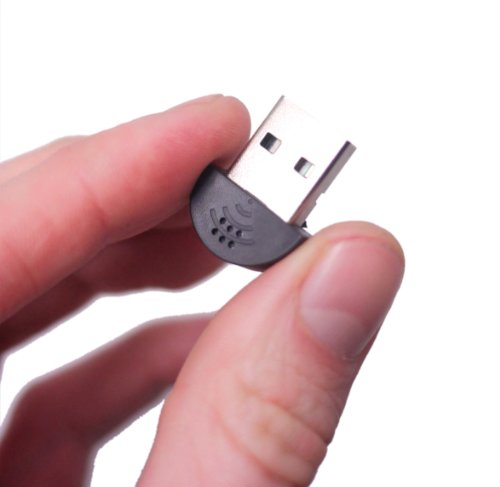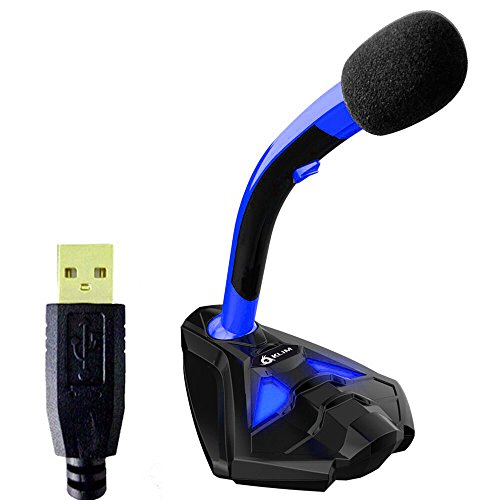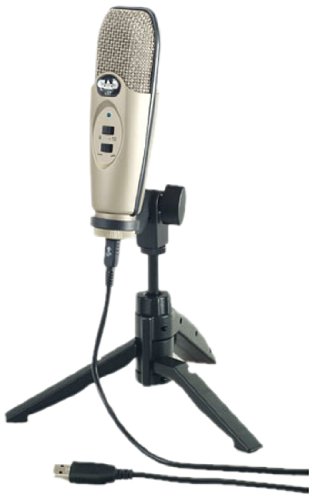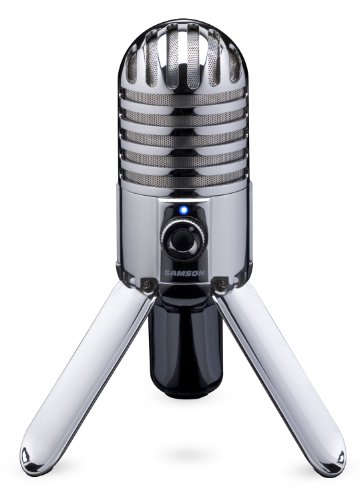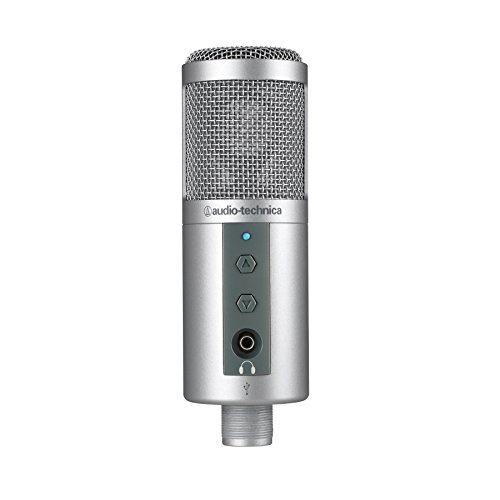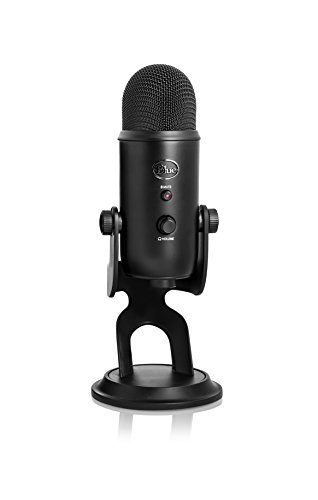Finding the best USB mic for your needs can be a bit of a challenge. To make things easier for you, the Music Critic team has tested out the top microphones and reviewed them for your convenience.
Due to the ever-increasing and changing of musical applications, there was a need to change the dynamics of microphones so they could easily adjust to these changes. As a result, there are many types of microphones available on the market, and it can get pretty confusing.
Table of Contents
- Best USB Microphone for Recording at Home in 2024
- 1. Blue Snowball iCE Condenser USB Microphone
- 2. Blue Yeti USB Microphone
- 3. USB Microphone, Fifine Plug & Play Home Studio USB Condenser Microphone
- 4. eBerry Plug and Play Home Studio Adjustable USB Desktop Microphone
- 5. Kinobo - USB 2.0 Mini Microphone "Makio" Mic for Laptop/Desktop PCs - Skype / VOIP / Voice Recognition
- 6. KLIM Desktop USB Microphone Stand for Computer Laptop PC and PS4
- 7. CAD U37 USB Studio Condenser Recording Microphone
- 8. Samson Meteor Mic USB Studio Microphone
- 9. Audio-Technica ATR2500-USB Cardioid Condenser USB Microphone
- USB Microphone Buyers' Guide
- The Comparison
- The Ability to Convert to Digital Audio
- Sample Rate
- Bit Depth
- Latency
- Whether to go for a condenser or a dynamic microphone
- The Microphone's Diaphragm Size
- Polar Patterns of the Microphone
- Cardioid Microphones
- Omnidirectional Microphones
- Multi-Pattern Microphones
- USB Microphone Features
- Top Pick
- Premium Choice
- Great Value
- FAQs
Below is the list of some of the best USB microphones of all time. If you're looking for a more professional mic, see the top ribbon mic reviews.
At a glance: Our top 3 picks
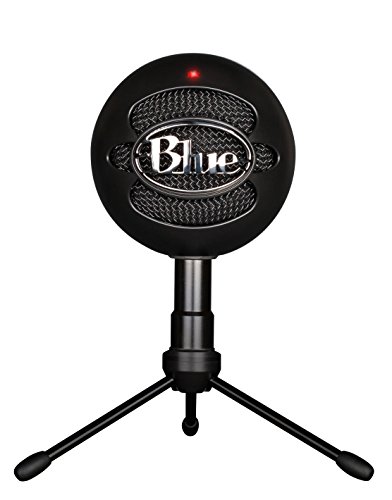
Blue Snowball iCE Condenser USB Microphone

- Custom condenser capsule, so you get nothing less than the best quality audio whether for Skype or FaceTime.
- Even if you are looking to use it for recording for YouTube it will deliver clear audio.
- Plug and play to use it; no drivers needed.

Blue Yeti USB Microphone

- Custom condenser capsule, so you get nothing less than the best quality audio whether for Skype or FaceTime.
- Even if you are looking to use it for recording for YouTube it will deliver clear audio.
- Plug and play to use it; no drivers needed.

USB Microphone, Fifine Plug & Play Home Studio USB Condenser Microphone

- Custom condenser capsule, so you get nothing less than the best quality audio whether for Skype or FaceTime.
- Even if you are looking to use it for recording for YouTube it will deliver clear audio.
- Plug and play to use it; no drivers needed.
Best USB Microphone for Recording at Home in 2024
1. Blue Snowball iCE Condenser USB Microphone
If you're looking to get the highest quality sound for you voice that will surpass your computer’s microphone the Blue Snowball iCE Condenser Microphone, Cardioid is the perfect pick for you.
Pros:
+ Custom condenser capsule, so you get nothing less than the best quality audio whether for Skype or FaceTime.
+ Even if you are looking to use it for recording for YouTube it will deliver clear audio.
+ Plug and play to use it; no drivers needed.
Why We Liked It- This USB microphone is available at a great price and it's easy to use, no drivers needed. It's one of the best.
Looking for a budget option? We've reviewed the top USB mics under 100 dollars.
Maintenance - With USB microphones, it's imperative that you keep your connecting USB cables in tip top shape. A damaged cable can cause latency issues and negatively impact your recording. Keep your cables untangled and stored safely when not in use.

2. Blue Yeti USB Microphone
The Blue Yeti USB Microphone is a plug and play microphone that you can use to record the high quality audio directly into your computer without any hassle. You can use it straight out of the box. Record anything with this microphone – it uses state of the art tri-capsule technology for studio-quality recordings.
Pros:
+ These microphones are capable of recording anything thanks to the tri-capsule array.
+ Comes equipped with four different pattern modes for incredible versatility.
+ Also has gain control, a mute button, and a headphone jack so you can listen while recording
Why We Liked It- If you want the best studio-quality recordings with the freedom of recording anything regardless of the situation, the Blue Yeti USB Microphone is definitely the option to go for. Make sure you grab a suitable pop filter for your Blue Yeti microphone.
3. USB Microphone, Fifine Plug & Play Home Studio USB Condenser Microphone
The Fifine Plug &Play Home Studio USB Condenser Microphone is excellent when it comes to delivering the best-quality recordings thanks to the cardioid pickup pattern which omits background noises and give you the best vocals.
Pros:
+ Easy to use interface.
+ This USB microphone is equipped with wide frequency response so that you only get transparent quality sound.
Why We Liked It- This USB microphone, fine Plug &Play Home Studio USB Condenser Microphone is a great all rounder.
Use Case - Determine your use case before picking out your USB microphone of choice. Someone who is hoping to record vocals or live instruments will have very different needs than someone who wants to record a podcast, or simply have better sound input. Also, make sure that your USB microphone of choice comes with all of the accessories you need to comfortably align the microphone on your desk.

4. eBerry Plug and Play Home Studio Adjustable USB Desktop Microphone
No matter what your application, whether you're hosting your own podcast or you just want to chat on Skype, this USB microphone is largely capable of catering to all your needs with the utmost of ease.
Pros:
+ Great sound quality.
+ Plug and play nature making it easy to use.
+ Designed to give you crisp, clear sound, as it filters out almost all background noises.
Why We Liked It- WThe eBerry Plug and Play Home Studio Adjustable USB Desktop Microphone is available for under $10. It may not have a load of extra features, but it gets the job done well.
5. Kinobo - USB 2.0 Mini Microphone "Makio" Mic for Laptop/Desktop PCs - Skype / VOIP / Voice Recognition
The Kinobo - USB 2.0 Mini Microphone "Makio" Mic for Laptop/Desktop PCs - Skype / VOIP / Voice Recognition is certainly the world’s smallest USB microphone. Despite its small size, it's still a top quality mic for voice detection apps and simple chat on Skype.
Pros:
+ Smallest USB microphone in the world, so it's great if space is an issue.
+ Direct plug and play interface, no drivers needed.
+ This microphone is an omni directional microphone and can pick up sounds from a distance but also has noise cancellation abilities.
Why We Liked It - The Kinobo USB 2.0 Mini Microphone "Makio" Mic for Laptop/Desktop PCs - Skype / VOIP / Voice Recognition is the smallest USB microphone, and with such an outstanding price tag it's a fantastic buy.
6. KLIM Desktop USB Microphone Stand for Computer Laptop PC and PS4
The KLIM Desktop USB Microphone Stand for Computer Laptop PC and PS4 is equipped with a USB microphone. It also has some additional features that make it a standout product.
Pros:
+ Patented audio filter that eliminates background noise for clear audio. It also comes with pop filter (click here for our full guide).
+ Plug and play, no software needed.
+ Comes with LED lights, volume control, and a mute button.
+ Highly durable; made from reinforced plastic and the interior is all metal and also reinforced.
Why We Liked It- The KLIM Desktop USB Microphone is compatible with laptop, PC ,and PS4 and to top that, you also get some great features for a low price.
7. CAD U37 USB Studio Condenser Recording Microphone
You won't find a lot of brands that can compete with CAD Audio as far as audio solutions for professionals and performers are concerned. When you talk about innovative, cost-effective, high performance live and studio microphones there's no parallel to the CAD Audio. So you know you can expect the very best from the CAD U37 USB Studio Condenser Recording Microphone.
Pros:
+ Capable of warm, rich recording thanks to its large condenser microphone.
+ The pick-up pattern uses a cardioid which minimizes background noise and isolates the sound source at the same time.
+ Equally good for singing, instruments, and speech due to extended frequency response.
+ Equipped with a bass reduction switch that reduces unwanted room noise.
Why We Liked It- The CAD U37 USB Studio Condenser Recording Microphone is pretty amazing with all of its extra features.
8. Samson Meteor Mic USB Studio Microphone
Whether you're a recording artist or a performer, an educator or an audio professional, Samson Technologies have a complete range of products to satisfy all your needs. This why it's preferred by people all over the world. The Samson Meteor Mic USB Studio Microphone is one of the best USB microphones you'll find. It has all the necessary things that you will find in the most expensive of the USB microphones but at much a lower price.
Pros:
+ Largest condenser diaphragm of 25mm that you will ever find in a USB microphone.
+ Cardioid pickup pattern and smooth frequency response.
+ This USB microphone comes in equipped with 1/8” headphone jack so you can easily monitor while recording with absolutely no latency at all.
Why We Liked It - This is one of the best USB microphones of all time and is available at a pretty inexpensive price, but still has all the qualities that you'll find on an expensive USB microphone.
9. Audio-Technica ATR2500-USB Cardioid Condenser USB Microphone
Whether for podcasting or home studio recording, field recording or a voice over, the Audio-Technica ATR2500-USB Cardioid Condenser USB Microphone, is a serious contender for one of the best on this list. After all, this is Audio-Technica we're talking about. The durability that you can expect from this product further proves Audio-Technica's expertise in their products.
Pros:
+ Has a side-address condenser with a large diaphragm.
+ This USB microphone comes equipped with a built-in USB jack so you can monitor your recordings easily without audible delay.
+ This microphone comes equipped with easy-to-use controls.
Why We Liked It- With an appealing price, the Audio-Technica ATR2500-USB Cardioid Condenser USB Microphone delivers the best.
USB Microphone Buyers' Guide
There was a time when recording of audio was considered to be a pretty big task, but thanks to the advancement of modern technology, this task is now easy. No matter how challenging a recording situation is, you can always make a quality recording using a good microphone.
There are a lot of different microphones available and all of these microphones are designed to serve a different purpose. If you've made up your mind to buy a USB microphone, it's best to do some research before choosing which microphone to buy; they each have different qualities and specs on offer. In this way, you can buy the best USB microphone to suit your needs.
The Comparison
An important thing that should be kept in mind is that a USB microphone has both advantages and disadvantages compared to traditional microphones. Ultimately, it's a matter of personal preference and what you actually want out of your own microphone that will be the determining factor of whether you opt for a USB or traditional microphone.
One of the advantages of a USB microphone is that they're easy to use. Most USB microphones have a plug-and-play option, so you can start using the microphone straight out of the box without installing any software and drivers. You also don't need any additional audio equipment when using a USB microphone, unlike traditional microphones. If you have a computer or a laptop with a USB port, the process is simple. Plug the USB connector into the port and your USB microphone will automatically be enabled and ready to use.
Since USB microphones don't require any additional audio device or a separate interface, they're really cost effective compared to traditional microphones. USB microphones are a great option for anyone on a tight budget. On the other hand, USB microphones have their own limitations. We all know that mixing boards and audio interfaces take the audio quality of the microphone to an entirely different level and they are more often used with traditional microphones. For cheap options, try these audio interfaces for under 200 dollars.
The Ability to Convert to Digital Audio
When discussing traditional microphones, the analog to digital conversion is done by audio interfaces or mixing boards. This isn't the case with USB microphones because this capability comes built-in with a USB microphone. So you have to be very particular about this factor because it will affect three important things and later on, will have an impact on the overall recording quality of the microphone. The three things that the digital conversion depends upon are the sample rate, the bit depth, and the latency of the microphone.
Sample Rate
The speed at which the microphone is able of capturing frequencies audible to the human ear is referred to as the sample rate. Now you have to be very selective. The USB microphone you buy should have at least the standard sample rate of 44.1 kHz.
Anything less means that your microphone won't be able to provide you with quality recordings. Professional AV equipment is generally between 48 and 96 kHz; this equipment is specially designed for the best editing options and the best definition.
Bit Depth
Bit depth will actually determine the details and the clarity that you get from your recordings. The bit depth should also be at a minimum of a standard level, int his case 16 bit. Professional audio is generally 24-bit depth. This depth is also found in some of the high-end USB microphones.
Latency
The latency is the time delay that you'll find in microphones. By delay, we're referring to the time taken from when you speak into the microphone to converting it into digital a signal and then being able to hear it in your headphones. The entire duration from speaking to hear is the latency of the microphone. If you're using a microphone for monitoring simultaneously with recording, this is really important. The lower the latency, the better the quality of the microphone.
Going for a USB microphone with the lowest latency rate is ideal for optimum performance. You'll find some USB microphones on the market that have a headphone output on them, and this actually helps in completely eliminating or reducing the latency to a great extent so that you can monitor your recordings in real time.
Whether to go for a condenser or a dynamic microphone
Dynamic microphones (click here for the top 10) are more commonly used for in-house applications like live stage performances. Dynamic mics are the more rugged of the two and can handle large sound sources. At the same time, dynamic mics are also very good at reducing handling noise, hence their use in live stage applications.
Condenser mics are usually found in USB microphones. Since the application of USB microphones is primarily an in-house or an in-studio one for the purpose of recording, they use condenser mics that have a reputation of delivering better transient response and also extended frequency response.
There are some high-end dynamic microphones available that come equipped with a USB port so that you can easily use them, regardless of the application.
The Microphone's Diaphragm Size
Whether using a traditional microphone or a USB microphone, the size of the diaphragm is equally important. Since the diaphragm of any microphone is the first component in picking up the sound, the size of it does indeed matter. If the diaphragm of the microphone is big, it has a better capability of picking up lower sound frequencies compared to microphones with a smaller diaphragm. The sensitivity of a large diaphragm microphone, when compared with a smaller diaphragm microphone, is also much better.
Small diaphragm microphones are really good at recording acoustic instruments like guitars and in addition to high-pitched instruments.
Polar Patterns of the Microphone
You need to determine the application of your microphone before hitting the stores and picking one up. The different polar or pickup patterns are described below to help you make the best decision.
Cardioid Microphones
There's a reason why this type of microphone is called a cardioid; its shape is like the human heart. Cardioid microphones are best known for picking up sounds from only the front and reducing sounds coming from the sides. If you're recording sound in a room but don't want any unnecessary external room noise, then this type of pickup pattern is the best choice for you.
Omnidirectional Microphones
When you want to capture all the sounds in the room, record instruments or even simply record the voices of several people speaking or singing at the same time, the omnidirectional microphone is your best bet. Since they have the ability to pick up sound from multiple sources and from multiple directions, they are best suited for this application.
Multi-Pattern Microphones
The multi-pattern pickup is equipped with both the patterns we just covered. For this reason, it's also known as a switchable microphone. There will be situations when you want your microphone to have a cardioid pickup pattern, but other times you may want an omnidirectional pickup pattern. If you have a microphone capable of providing you with both options, it increases the flexibility that you get from your microphone.
USB Microphone Features
Unlike traditional microphones, USB microphones usually come equipped with a number of features and control switches. Some of the features that you'll get with USB microphones are a volume control, so that you may have complete command over the output of your microphone; a polar pattern switch as mentioned earlier; a bass boost switch or a mute button to actually cut off the microphone’s signal. The more features a USB microphone has, the more you should expect to pay for it.
Top Pick
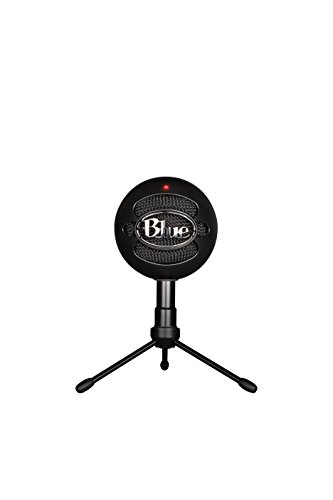 Blue is one of the best brands in the USB microphones business. It's renowned for coming up with exceptional USB microphones which are compatible with all sorts of applications but are also equipped with numerous features.
Blue is one of the best brands in the USB microphones business. It's renowned for coming up with exceptional USB microphones which are compatible with all sorts of applications but are also equipped with numerous features.
The Blue Snowball iCE Condenser Microphone is one of the very best of the USB microphones available. It has everything you'd expect from the very best. It's a condenser microphone so it captures crystal clear audio. It's also considered to be a very good microphone for your YouTube recordings. You can use it directly out of the box as it's plug and play.
Premium Choice
The Blue Yeti USB Microphone is one of the best USB microphones of modern times. It's capable of giving you all the necessary features and outputs that you could want in a USB microphone. It's equipped with multiple polar patterns to give you plenty of flexibility.
It uses tri-capsule technology to give you the very best recordings regardless of the situation. It also comes in with a gain control and mute button. This is arguably the perfect choice for anyone looking to get the best quality USB microphone; it's capable of doing wonders.
Great Value
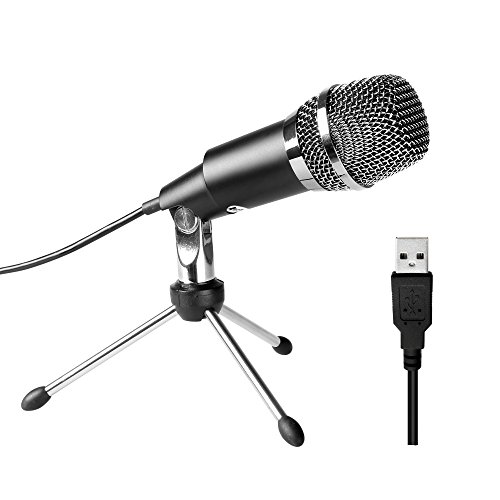 The Fifine Plug & Play Home Studio USB Condenser Microphone for Skype, Recordings for YouTube, Google Voice Search, Games(Windows/Mac)-K668 has everything packaged into an affordable, great quality mic.
The Fifine Plug & Play Home Studio USB Condenser Microphone for Skype, Recordings for YouTube, Google Voice Search, Games(Windows/Mac)-K668 has everything packaged into an affordable, great quality mic.
This USB microphone comes with a wide frequency response so it only delivers brilliant sound. This USB microphone uses a cardioid pattern so that it only picks up sound from the main audio source and eliminates any unwanted room sound. The audio that you get from this microphone is crystal clear without any hiccups or unwanted sounds.
Whatever you are using the USB Microphone, Fifine Plug &Play Home Studio USB Condenser Microphone for Skype, Recordings for YouTube, Google Voice Search, Games(Windows/Mac)-K668 for recording the best quality singing or speak, or simply using it for Skype chatting, this USB microphone is just amazing.
FAQs
Are USB Microphones Any Good?
If we talk about the functionality of the USB microphones when compared to the traditional microphones, they are good and tick off all the boxes.
USB microphones are as good as traditional microphones since the working mechanism of both is almost the same. As far as the effectiveness of the microphone is concerned, you can bet USB microphones are excellent.
Do USB Microphones Provide the Same Sound Quality?
The answer to this question is a simple yes. USB microphones are capable of providing almost the same sound quality as traditional microphones. The major difference between the two is the difference in applications that they are used for. Traditional microphones are used in live settings while USB microphones are used more of in-house or in-studio.
What Should I Look for When Choosing a USB Microphone?
Here are a quick recap and overview of the things to look for when going for a USB microphone.
- Its ability to convert to digital audio
- The size of its diaphragm
- The polar patterns that it has
- The features that it is equipped with
What are the Best USB Microphones?
All the microphones on this list have the ability to serve the purpose for which they are designed for and are considered to be the best on the market. If they have any extra features it just adds icing on the cake.
Read Also: Top 10 Microphones for Recording Singing in 2024
What is the Best USB Microphone for Home Recording?
As has already been stated above, the primary application of the USB microphone is in-house, so most of the USB microphones that are considered to be good are great at providing the best quality for home recordings. If you want to be a bit more specific though; USB microphones with extended frequency response are really good for home recordings.
Gain Knob Benefits - For recording vocals or live instruments, having an embedded gain knob on the microphone itself can be extremely helpful. This way, you can easily capture just enough sound and seamlessly switch up your settings for recording different sources. While you can do this within your DAW to a degree, this feature undoubtedly gives you more control over your sound.

If you liked this review, please leave a positive rating:


